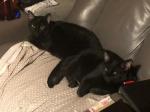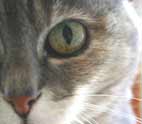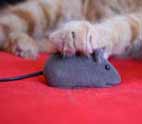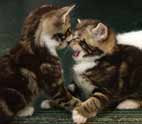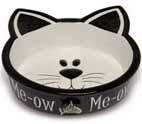Kitten Food & Hand Rearing Kittens
Which is the best kitten food to feed your newborn kitten or young cat?
Knowing what food to feed your kitten can be quite a worry, especially if they have been orphaned and have not received the benefit of their mother's first milk which contains essential antibodies to help fight illness.
It can be quite a daunting task to take on the responsibilities of keeping your kitten healthy and providing the extra kitten care they need especially if they are very young.
This page is all about how best to do this without the stress and worry, practical advice without too much of the science. It will mainly cover advice for looking after newborns who rely totally on you for their food.
What's So Great About The Mother Cats Milk?
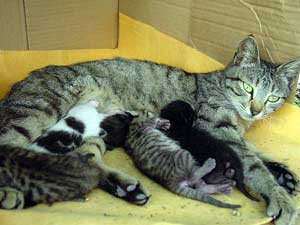
The cat mother's milk is very important for the health of newborn kittens. It will change composition over the weeks as the kittens needs change also and trying to replicate food that also changes can be a fine balance.
The mothers' milk contains colostrium for the first 12 to 24 hours. This contains the antibodies the kittens need for protection against illness. It is also lower in protein, fat, lactose and is higher in moisture than normal cow's milk.
Not even the best kitten food milk can be formulated to exactly duplicate the queen's milk and so if you do have a kitten that has been orphaned from birth they will require a lot of extra care to prevent illness.
A kitten's intestines when first born are not fully developed and cannot digest some foods. Over-supply of some nutrients can therefore cause diarrhea and lead to dehydration which can lead to death.
If you do have to hand-rear your kittens, then you will have to learn the correct feeding schedule and other kitten care techniques, as well as providing the best kitten food to ensure they thrive into healthy cats.
Commercially Bought Kitten Food For Hand-Rearing
Do NOT feed whole cow's milk!
Whole cow's milk is not suitable for feeding kittens because it does not contain enough of the vital fats and protein levels required to promote proper growth. Cow's milk will also cause diarrhea for the new born kitten will as it will not be able to digest the lactose in the milk.
There are several cat milk replacements that are available to buy and are the best kitten food to use if you can get it for your kittens.
It is specially developed to contain enough extra moisture and the level of solids similar to that of natural cat's milk.
Using the powder version such as KMR Kitten Milk Replacer Powder is less wasteful and more economical, but care needs to be taken when blending it to ensure that it is not lumpy and can pass through feeding nipples. Here are some useful tips when using powdered kitten milk:
- Add powder to water
- Sprinkle a little at a time mixing as you go
- Use cold water to mix and warm it to feed
- Use a blender if available
- For newborns add extra water for the first two days to make the solution thinner, as moisture is very important during these first days.
|
|
Home Made Milk Substitutes For Kitten Food
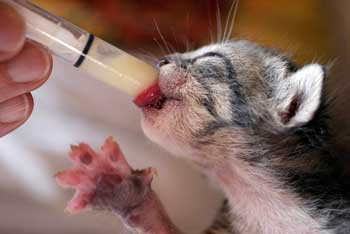
If you cannot easily buy formulated kitten milk then your only alternative is to try and make your own suitable kitten milk yourself. The golden rule for newborns is that you need to add one third to one forth extra moisture to your mixes for the first few days.
Homemade substitutes are:
- Two thirds of a cup of whole cow's milk with one third non-fat dry milk powder and 1 tablespoon of vegetable oil
- Two thirds of a cup of whole milk with half a cup 18% coffee cream
- 1 cup whole milk with quarter of a cup 30% whipping cream
- 1 cup evaporated whole milk (never condensed milk) with half a cup of water
Remember, if you can buy commercial kitten food milk that is far the better solution for your kittens' nutritional requirements.
Kitten Care Feeding Schedule & Amounts
Kittens will feed from their mother 10 to 20 times a day, only taking a little each time. This is not practical when feeding kittens by hand, so you will have to set up a schedule for feeding that doesn't allow the kittens to go hungry, but will ensure they receive enough food to enable them to thrive.
For normal healthy kittens feeding every 6 hours is sufficient. If the kittens are a little weaker then reduce this time to every four hours.
Bottle-feeding amounts:
Kittens should be consuming at least 3 to 4 ml for every ounce of their body weight.
Tube feeding amounts:
Feed 8 to 10 ml for every 4 ounces of the kittens' body weight. This should be done slowly so as not to over feed or cause inhalation of the milk.
|
|
Tools For Feeding Kittens
The easiest way to feed a kitten is to use a commercially bought kitten feeding bottle with a rubber nipple attached at the top. It is important to note that the rubber nipples supplied for human babies are far too large and are the wrong shape for the mouths of kittens. Special sized ones for feeding kittens can be bought from pet stores and vet surgeries.
It is important that the correct nipple is obtained, as it will help stimulate the kitten into feeding. They usually require a long thin nipple that can reach far back into their mouths.
If you have a kitten that finds it difficult to suckle then the other way of feeding is via a tube that is passed directly into the kittens' stomach. You will need to buy a stomach tube that is known as a size 8 French, 15 inches in length (6 French for very small premature kittens).
These specially designed stomach tubes will be available from your vet surgeries. They have a fitting on one end that is designed for a syringe to be attached to it, so that the correct amount of kitten food can be administered.
Never use an eyedropper as a feeding tool unless it is an emergency. They are not very efficient tools for feeding and the kitten cannot suckle on it. It may also allow too much fluid to enter the mouth causing the kitten to choke.
For more great kitten care tips, view my other pages on:
And Kitten Weaning to find out about moving on to solid kitten food.

